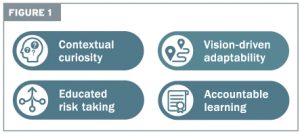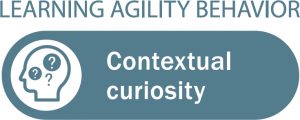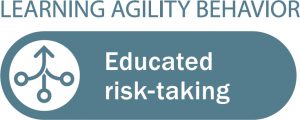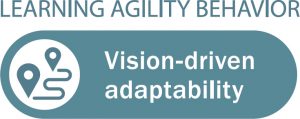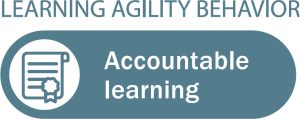FEATURE STORY – By Simon Kyaga, Keith Morris and Kiely Flanigan
Future-Proofing Strategic Planning for Medical Affairs
The COVID-19 pandemic has accelerated the need to develop Medical Affairs capabilities in learning agility. Not unlike various industry shifts over the years that have affected the role of Medical Affairs, we’ve experienced a shift in the way Medical Affairs organizations are responding to changes affecting the execution of strategic plans.
Field Medical is learning to engage stakeholders virtually and support healthcare providers (HCPs) in new ways as they engage with their patients through new technologies. Clinical trials adopted new protocols to protect patients and sustain recruitment. Conferences and congresses were postponed. Organizations are seeking flexible resourcing models to manage downturns in business and leveraging downtime to upskill team members.
 All these disruptions have required an openness to change and the development of new skills to learn new ways of achieving our work objectives. We are now not only shifting how we do our Medical Affairs work, but also planning for a “new normal” as we navigate doing business virtually.
All these disruptions have required an openness to change and the development of new skills to learn new ways of achieving our work objectives. We are now not only shifting how we do our Medical Affairs work, but also planning for a “new normal” as we navigate doing business virtually.
Yet, however uniquely disruptive COVID-19 has been, it is still only one more example of the bucket of business disruptions that have affected the skills, knowledge and capability needs within Medical Affairs work. At the heart of the changes asked of us and our teams is learning agility. As a core capability associated with managing ambiguity and figuring out what to do when you don’t know what to do next, learning agility is particularly relevant and useful in developing adaptive and dynamic Medical Affairs strategic plans that stand the test of change and disruption.
An Emergent Capability
Learning agility in strategic planning is important because by incorporating learning agility behaviors and mindsets into the development and implementation of strategic plans, teams are better able to pivot and innovate, as needed, to changing internal and external dynamics, while remaining in alignment to the overall medical vision and business objectives.
This article aims to position learning agility as an emergent capability that supports the future-proofing of Medical Affairs strategic planning processes and outputs. Our position is that learning agility is a capability that should be developed internally and applied to the development and operationalization of strategic plans. We then define four descriptive behaviors that map to aspects of Medical Affairs strategic plans and discuss how to apply those learning agility characteristics.
Medical Affairs Strategic Planning
Medical Affairs strategic plans include both intellectual components – such as situational analyses and medical strategies – as well as tactical components – including tactical and operational plans – and assessment and measurement metrics. Medical plans are important because they guide decision-making across the organization and support the communication and assessment of Medical Affairs’ efforts and impact.
Medical strategic planning is an integral part of setting strategic direction and articulating the tactics for driving Medical Affairs’ value and impact for patient and organizational outcomes. But how do you create a realistic and viable strategic plan given a VUCA (volatile, uncertain, complex and ambiguous) Medical Affairs ecosystem? What brings Medical strategic plans to life and ensures they get referenced more than once a year in the annual planning process? How do we make the strategic plan content memorable and keep it top of mind with our key audiences? We suggest that the secret to effective Medical Affairs strategic plans is learning agility.
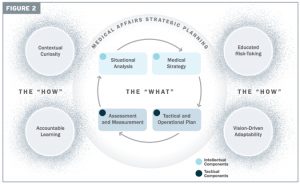
In a Medical Affairs context, learning agility brings key behaviors and mindsets into the Medical planning, development and execution processes that ensure the content contains relevancy and resonance for the organization. Although variations exist between companies in terms of influences affecting the strategic planning process (e.g., preferred timing of Medical support of launches, products, therapeutic area considerations and operational competencies versus strategic positioning priorities), the Medical Affairs planning process reflects multiple stakeholder insights, business objectives alignment and tangible data for strategic decision-making. The strategic plan is not intended as a fixed manual that is reviewed once a year.
Figure 1 shows several descriptive behaviors team members can use in approaching the development, communication and operationalization of strategic plans to support success.
Each of these behaviors is based on the capabilities needed to design, communicate and execute on a strategic plan. The descriptiveness of the terms reflects a desire to position these learning agility behaviors as both foundational and aspirational. Learning agile behaviors is critical for the here and now in performing work, as well as for guiding toward the future and inspiring learning and development.
 Learning Agility
Learning Agility
Learning agility is relatively new to the Medical Affairs scene, but it is starting to see more traction as our industry seeks to build capabilities in individuals and teams to navigate and harness the rapidly changing nature of Medical Affairs. Originally used to develop the managerial capabilities of high-potential, high-performing talent, learning agility can be applied not only at the individual level, but also at the team and
organizational levels, and is associated with higher levels of organizational performance. For the purposes of this article, we’ll focus on developing learning agility at the individual level and use the following definition: Learning agility is a capability associated with adapting to change and uncertainty by applying previous lessons learned.
Learning agility requires both adaptively changing and proactively innovating in times of ambiguity. Learning agility activates the value and impact of Medical Affairs strategic planning components (i.e., situational analysis, medical strategy, tactical and operational plans, and assessment and measurement metrics) despite change and shifting expectations internally and externally.
When it comes to Medical Affairs strategic plans, it is no longer sufficient to rely on the intellectual and tactical domains of competence. Successful Medical Affairs strategic plans reflect a collective organizational capability — an integrated representation of knowledge, skill and mindset — that brings to life within the plan the flexibility to adapt, learn and pivot toward changing needs. Learning agility is the “how” behind the “what” of Medical Affairs’ strategic plans.
The integration of learning agility and Medical Affairs strategic planning is important to how both strategic and day-to-day operational decisions are made. This is even more important today as Medical Affairs is being asked to communicate and demonstrate its impact and value within competing priorities from more diverse and increasingly challenging internal and external stakeholder needs. In addition, due to COVID-19 disruptions, including closed conferences, Medical Affairs is forced to reconsider how to communicate and how to balance between strategy and tactics in an uncertain environment.
Mapping Learning Agility Behaviors
Using the strategic planning framework developed by the Medical Affairs Professional Society (MAPS), let’s look at the fundamentals of Medical strategic planning and suggest related learning agility behaviors and mindsets that are instrumental to both intellectual and tactical outcomes.
The learning agility behaviors form a kind of permeable flexibility and protection that ensures the strategic plan is created and maintained with maximum adaptiveness. Learning agility brings strategic plans to life and articulates specific behaviors that support the strategic plan having bigger impact through greater relevancy. A strategic plan must be relevant to have impact and the learning agility behaviors associated with MAPS’ four elements of strategic plans makes them applicable for the teams using them.
Situational Analysis
Contextual Curiousity Application
Facilitate a scenario-planning workshop with cross-functional representation to pressure-test internal and external situational analyses as part of the Medical Affairs annual strategic planning process. Build hypotheses about how payer pathways and patient journeys affect each other, for example. Examine hypotheses through different perspectives and apply findings to potential future scenarios. Use curiosity to create detailed context frameworks and maps of the current Medical Affairs situation.
Key Questions: Where are we now? What is our current situation?
Contextual Curiosity Characteristics
Thinking independently and creatively beyond taken-for-granted frameworks. Ability to question critically and collaborate to better understand how various stakeholders envision the situation from differing frames of reference. Intellectual curiosity and an ability to see contexts beyond the data. Make sense of emerging patterns and trends (this is different from simply solving problems).
Medical Strategy
Educated Risk-Taking Application
Risk-taking is a tough sell in Medical Affairs, given the criticality of science expertise and regulatory compliance underscoring scientific exchange, evidence generation, disease state education and other key activities driven by Medical Affairs. Yet, innovation thrives on new ways of thinking and working. By taking a disciplined and methodical approach to medical planning, we can engage in educated and informed risk-taking.
As Louis Pasteur remarked, “chance favors the prepared mind.” There is no opposition between knowing things and risk-taking. Our interpretation is that risk taking is not about guessing. Rather, the probability of success is higher when trying something new when one prepares.
Key Questions: Where do we want to be versus current gaps? What do we need to do to get there?
Educated Risk-Taking Characteristics
Anticipating potential opportunities and risks with logic. Establishing clarity in direction to enable pivots in strategy or tactic, while staying in alignment with the overarching Medical Affairs objectives. Communicating credible visions of possibilities that motivate learning and action.
Ability to deliver a clear connection between vision and action.
Tactical and Operational Plan
Vision-Driven Adaptability Application
The rapidly changing science and environmental changes will likely warrant medical strategy amendments. In the deployment of specific tactics, be open to the regional/local nuances that may affect direct execution of the tactic. Be flexible in navigating adaptations to the tactic, based upon the stakeholder type, for example, within the broader umbrella of the strategic vision and objectives.
Key Questions: How do we get there? What are the actions, tactics or initiatives that will achieve the strategic goals?
Vision-Driven Adaptability Characteristics
- Ability to act quickly and decisively to take advantage of new opportunities.
- Comfort in acquiring, building, sharing, redeploying and applying knowledge and lessons learned.
- Able to redistribute resources, as needed.
- Takes the time for re action in order to spur innovative thinking for problem solving.
- Keeps the big picture in mind while operationalizing tactics.
- Embraces discomfort and exhibits a willingness to try something new to achieve the desired vision and outcomes.
Assessment and Measurement
Accountable Learning Application
In Medical Affairs, there is a seeming incongruity between being a lifelong learner (the vulnerability that comes from learning new things) and the need for engaging in credible scientific exchange (the competency that comes from being the scientific expert). One way to counteract this tension is to establish a culture of change and openness to learning (and possibly failing).
Facilitate accountability in individual/team actions and conduct after-action reviews to understand failures and how to learn from them. Allow individuals and teams to self-assess what went well and what could have gone differently. Institute a disciplined process for assessment and measurement. People can walk away from the same experience with wildly different takeaways and understandings of that experience. Identify what to keep and what to lose. Structure and feed assessment data back into situational analyses and the next wave of strategic planning.
Key Questions: How has the market evolved? Does our strategy resonate outside our organization? What is the impact of our efforts?
Accountable Learning Characteristics
- Ability to reflect on experience and factor that learning into future goals and objectives.
- Willingness to take accountability for one’s own actions and reactions.
- Mindset of seeking feedback and other information to support development
and improvement. - Accountability is key—as measuring impact is at the core of the Medical Affairs value proposition.
Simon Kyaga is global medical lead, psychiatry, for Servier. Keith Morris is executive managing director, scientific and medical affairs, Syneos Health. Kiely Flanigan is director, medical affairs, Syneos Health. Email the authors through kiely.flanigan@syneoshealth.com.

